BLUE CONE MONOCHROMACY (BCM) SIMULATION GLASSES
by Dean Monthei – September 2023
INDEX
- APPENDIX 1 – METHOD TO SIMULATE THE VISION OF A SPECIFIC PERSON WITH BCM
- APPENDIX 2 – ALTERNATE METHOD TO SIMULATE THE VISION OF A SPECIFIC PERSON WITH BCM
- APPENDIX 3 – TECHNICAL DETAILS ABOUT HOW THE GLASSES SIMULATE BCM COLOR VISION
Description:
A person with normal vision (a normal) can use these glasses to simulate Blue Cone Monochromacy color vision by blocking red light and to simulate poor visual acuity.
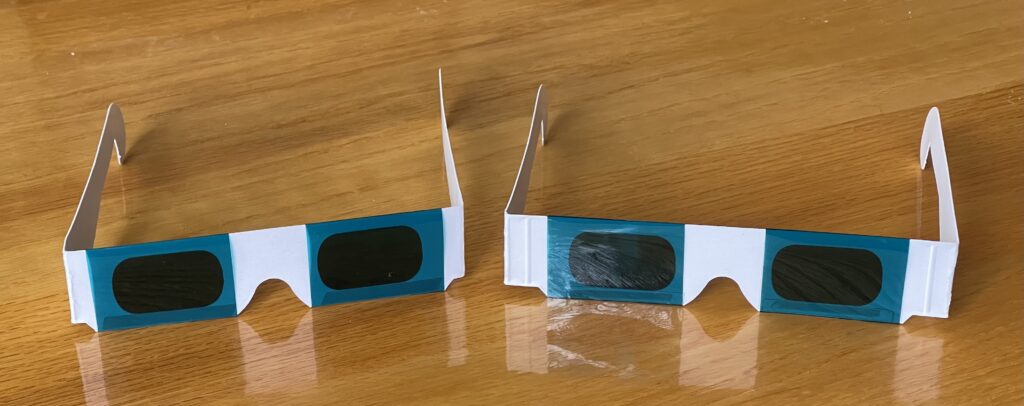
Figure 1: Type 1 and Type 2 BCM Simulation Glasses
Main symptoms of BCM include poor ability or inability to distinguish colours, and poor visual acuity, between 20/200 and 20/63 (poor detail vision).
There are 2 versions of the glasses available:
Type 1 – simulates BCM color vision by blocking red light – made with 2 layers of a red blocking filter ROSCO #2005 Cyan
Type 2 – simulates BCM color vision and poor acuity (blurry vision) – made with 2 layers of ROSCO #2005 Cyan and 1 layer of ROSCO #132 diffusion filter.
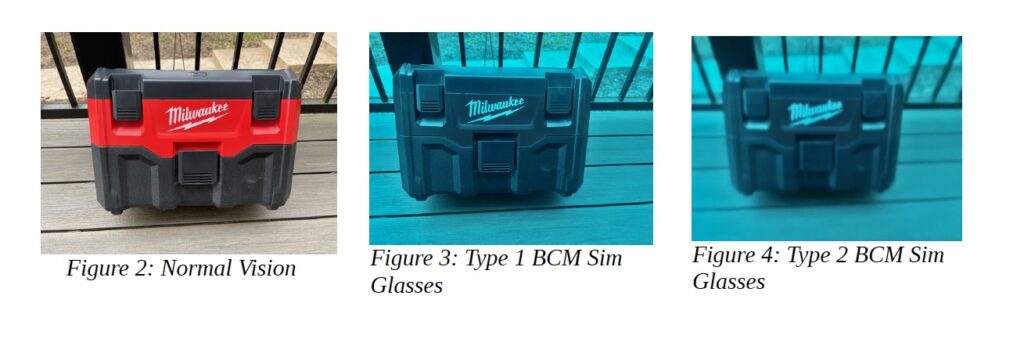
Instructions:
These glasses should be used over any glasses or contacts a normally sighted person uses. This provides a starting point close to 20/20 vision in the US or 10/10 in Europe. You can also use these glasses over a cell phone camera lens to get representative photos of BCM color vision. This is how Figures 3 and 4 above were made.
Limitations:
VISUAL ACUITY: The Type 2 glasses are worse acuity (blurrier) than is average for BCM which usually runs between 20/63 and 20/200. The type 2 glasses simulate worst case BCM vision of worse than 20/200. This was due to available diffusion filters. APPENDIX 1 and APPENDIX 2 discuss ways to simulate a specific person’s BCM acuity and color vision. The Type 2 glasses will give a good general impression of what worst case BCM vision is like. For people with normal sighted trying to experience what a specific person with BCM sees, the methods in the appendices may be worth doing.
COLOR ACCURACY: Not everyone with BCM has exactly the same color vision, so these glasses may not be an exact match for all individuals with BCM but they represent a reasonable approximation.
NYSTAGMUS: Another symptom of BCM that is not simulated with these glasses is infantile nystagmus, which in some cases persists into adulthood (involuntary rhythmical, repetitive eye movement).
PHOTOPHOBIA: The glasses cannot simulate the intolerance to bright light (photophobia) often a symptom of BCM. In some cases photophobia increases with age. Using these glasses over a mobile phone camera and significantly overexposing the image can coarsely simulate the additional color loss BCM causes in bright sun without sunglasses, but not the disconfort (Figure 5).
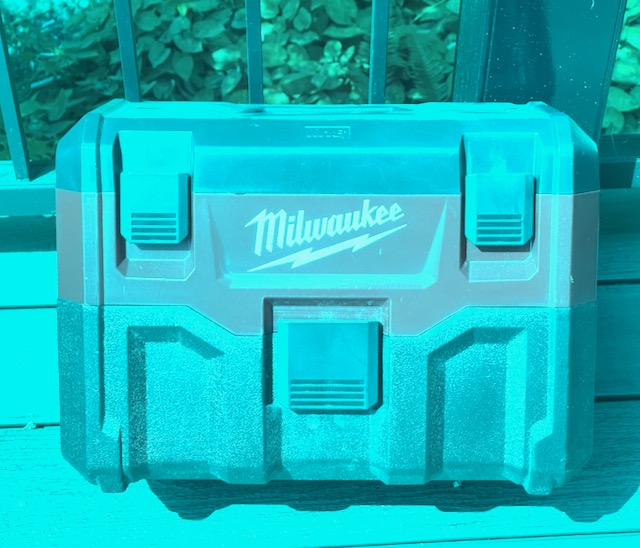 Figure 5 – Simulation of color loss in direct sun without sunglasses
Figure 5 – Simulation of color loss in direct sun without sunglasses
HOW TO REQUEST BCM SIMULATION GLASSES
Please send an email to info@bcmfamilies.org with the address to send the glasses and the number of Type 1 and/or Type 2 glasses you want. For small orders there is no charge for the glasses or shipping including international.
APPENDIX 1 – METHOD TO SIMULATE THE VISION OF A SPECIFIC PERSON WITH BCM
Lorem ipsum dolor sit amet, consectetur adipiscing elit. Ut elit tellus, luctus nec ullamcorper mattis, pulvinar dapibus leo.
Type 1 red blocking glasses can be used over low cost reading glasses (Figure 6). The reading glasses defocus an image to match BCM poor acuity and the Type 1 glasses simulate BCM color vision.
To do this, a normal and a person with BCM can go to a store that sells low cost reading glasses to test different diopter (strength) reading glasses to find a match for the BCM person’s acuity. In the USA, low cost reading glasses are sold at pharmacies.
 Figure 6: Reading glasses combined with Type 1 BCM simulation glasses
Figure 6: Reading glasses combined with Type 1 BCM simulation glasses
A normal can compare what they can read on distant signs using different diopter reading glasses with what the person with BCM can read. Try different diopter glasses until the normal is limited to reading the same size as the person with BCM. It may be useful to print out an eye chart from the internet to take with you to the store. The signs or eye chart should be 20 feet (6 meters) or farther away. Diopter values between +1.25 and + 2.5 should typically give the right level of poor focus. This will only be true for distant objects. Closer objects will be in better focus which is the purpose of reading glasses. If the normal wears glasses, the reading glasses should be in addition to (on top of) their glasses or contacts. Using these reading glasses and the Type 1 BCM simulation glasses together will then closely simulate the BCM person’s vision.
If you prefer not to go to a store, Amazon sells bulk reading glasses that are a mix of diopters (powers). At the time of this write-up, Amazon has 10 pairs of reading glasses that vary in diopters from +1.25 to+3.25 for about $20. Search on “bulk reading glasses variety pack” and make sure they are a mix of diopters. Some variety packs are a variety of colors, not diopters.
If you need many pairs of glasses for a class or group demonstration, you can buy bulk reading glasses of a specific diopter. Amazon has several suppliers selling 6 packs of reading glasses for around $13 and eBay has vendors selling 12 packs for $20. Even though these are cheap, they are useful for this purpose. One issue is that screws falling out of the BOOST EYEWEAR brand glasses shown in the photo in APPENDIX 2.
APPENDIX 2 – ALTERNATE METHOD TO SIMULATE THE VISION OF A SPECIFIC PERSON WITH BCM
You can make your own simulation glasses to match a specific BCM person’s eyesight without the cardboard frames. The ROSCO #2005 filter sheets are available in 20”X24” sheets (508X610mm) for less than $11 (Google search for “ROSCO #2005 sheet”). Narrow double-sided tape can be used to attach 2 layers of this film to the back of reading glasses as shown in Figure 7. The tape is available on Amazon in 2mm, 3mm and 5mm widths (sold as cellphone screen repair tape – $8 to $16 depending on width).
AMAZON and eBay have low-cost bulk reading glasses as noted in APPENDIX 1.
The flatter and more rectangular the back of the lens on the reading glasses, the easier it is to add the filter material.
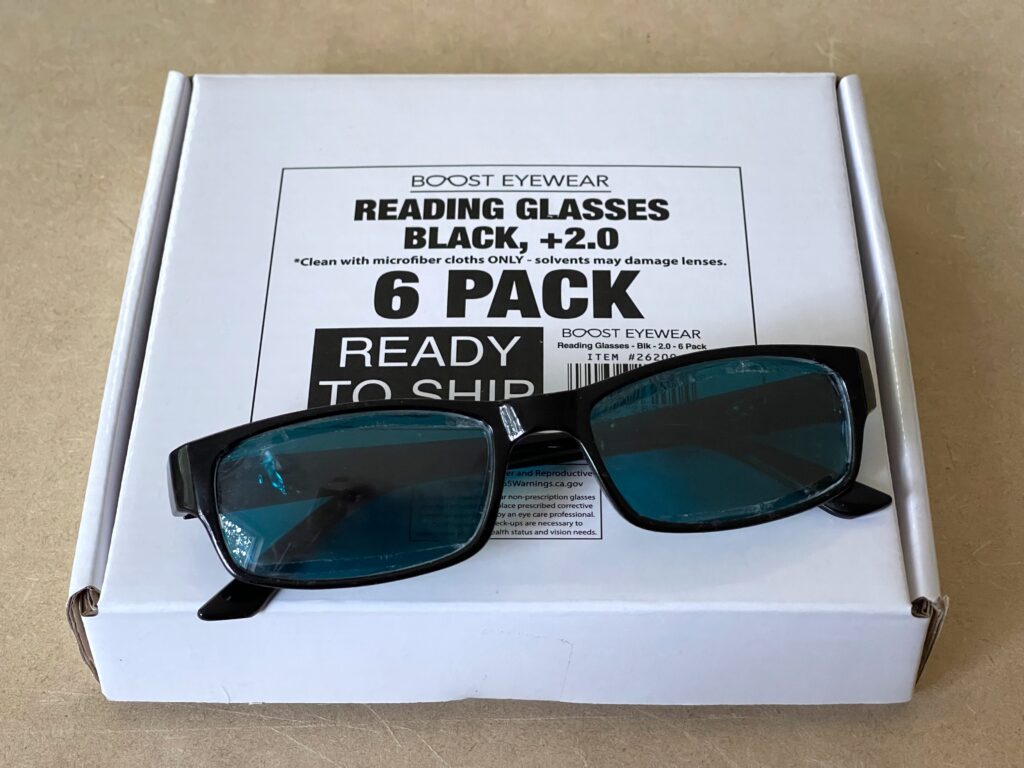
Figure 7 – Double layer of ROSCO #2005 attached to reading glasses using double sided tape
APPENDIX 3 – TECHNICAL DETAILS ABOUT HOW THE GLASSES SIMULATE BCM COLOR VISION
THE SIMPLE EXPLANATION
The short answer: the glasses block red light. These glasses make a normal see only blue and green. People with BCM see short wavelength blue colors using S-cones and medium wavelength (green-like) colors using their rods (a 2 color system – dichromacy)[1-4].
WHY AND HOW THE GLASSES WERE DEVELOPED
I have genetically-confirmed BCM. The development of the BCM simulation glasses was based on my observation that colors other people referred to as red usually looked black to me. My experience with color film photography pointed to the possibility of using filters to block red and simulate BCM color vision. This was tested and seemed to work when comparing my description of colors with family members while they looked through a red blocking filter (KODAK Wratten #44 cyan).
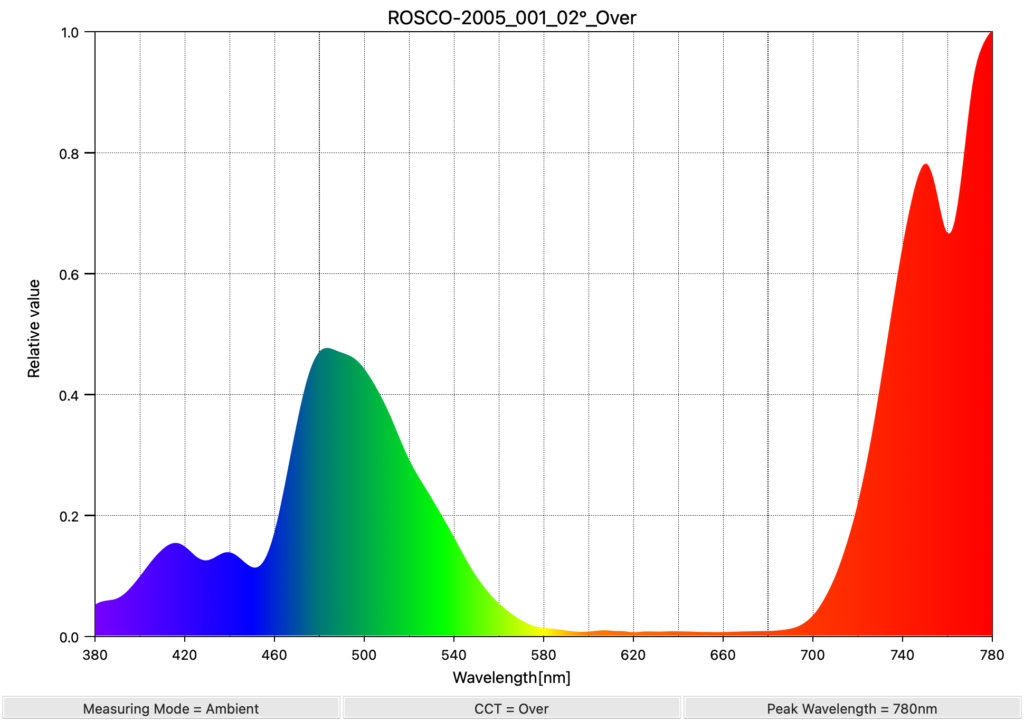
Figure 8 – Spectrum from sunlight passing through 2 layers of ROSCO #2005 filter material
ROSCO #2005 cyan filters are much cheaper than Kodak filters but require 2 layers to block enough red. Figure 8 shows the spectrum of sunlight passing through 2 layers. This filter is much lower cost at $10 for a 20”X24” sheet and is used in the BCM simulation glasses. Also, by using 2 layers of this cyan filter over a cell phone camera you can take photos that simulate BCM color vision.
The type 2 BCM simulation glasses use 2 layers of the cyan filter plus one layer of diffusion filter. The diffusion filter significantly reduces visual acuity to 20/400 or worse. This represents the worst case BCM acuity. Most BCM patients have 20/63 to 20/200 vision. This “worst case BCM acuity” film was used due to limitations of available filters. The diffusion film (ROSCO #132) is a rare type of embossed (bumpy) film that bends light in somewhat random directions. Most diffusion films look frosted/foggy reducing contrast too much to simulate BCM vision properly.
The filters are mounted to cardboard frames from American Paper Optics (https://www.3dglassesonline.com) using cell phone screen repair double sided tape from Amazon.
TECHNICAL EXPLANATION OF HOW THE BCM GLASSES WORK
To understand why BCM simulation glasses work, it is useful to understand color science and terms used by vision and lighting experts.
The Young–H elmholtz Trichromatic Theory [5] , the Principle of Univariance [6] and Metameric
Colors (metamers) [7] show that all colors sensed by humans (which are made up of complex mixture of different wavelengths of light) can be simulated by mixing primary colors of red, green and blue. These RGB primaries are how TVs and computer monitors reproduce colors by mixing various brightness levels of red, green and blue at each pixel on the screen. In eyes, blue is sensed by S-cones, green by M-cones and red by L-cones (S, M and L for short, medium and long wavelengths). Cone sensitivities vs. wavelength are shown in Figure 9.

Figure 9 – Wavelength sensitivity curves for human cones and rods
Figure 9 also shows a 4th type of light-sensing cell called rods which are used by normals and people with BCM in dim light. Rods have also been shown to have some influence on normal color vision in brighter light [8]. With BCM, rods are very significant to color vision even in medium light levels (indoors, dense shade outdoors, or in bright sun when wearing sunglasses).
HOW TRICHROMACY THEORY RELATES TO BCM
Blackwell published a paper in 1957 [9] titled “Blue mono-cone monochromacy: A new color vision defect” which presumably was shortened later to “Blue Cone Monochromacy”. Unfortunately, this name is confusing since many people with BCM have a 2-color system (dichromacy based on S-cones and rods) in all but dim light and bright sun. By 1961, Blackwell had confirmed that both blue cones and rods were used in BCM to form a dichromacy color system in medium bright conditions.
BCM would be more accurately named S-cone/Rod Dichromacy (SRD). Because “Blue Cone Monochromacy” was used as a description, many websites, videos and even doctors working in color vision state that people with BCM see in black and white (grayscale) or in monochromatic shades of blue. The implication is that this is true for all light levels. In bright sun with no sunglasses this is somewhat valid but for indoor lighting and in sun with sunglasses I definitely experience a dichromacy color system.
There appears to be differences in sensitivity and color perception levels among BCM people. As a result, the colors seen with the BCM simulation glasses may not match exactly everyone with BCM and some with BCM may perceive less color than others. My own BCM genetic causative mutation is the deletion type covering at least parts of the LCR and the red opsin promoter. The glasses have been found by several normals to reasonably match color descriptions by their BCM family members but the accuracy will vary with some individuals.
Age can also be a factor especially if a BCM person develops cataracts. My own cataracts made blues more muted (grayer) as I got older. This also happens for normals as well, resulting from the yellowish cast of the cataracts. Cataract surgery instantly corrects this.
Normals use M-cones (and possibly some rod signal) to sense medium wavelengths (greens) when using the glasses while BCM people use their rods for medium wavelengths as noted in previous references [1-4]. Normals and people with BCM should have similar color vision when normals use the BCM simulation glasses.
In direct sun with no sunglasses, my own color vision is much poorer (closer to monochromatic) and research has shown this for multiple BCM patients [10]. The BCM simulation glasses can still be used to compare colors to someone with BCM in direct sun but only if the person with BCM wears dark gray sunglasses to bring the light levels down to a comfortable level.
Cyan and white will look nearly identical to someone with BCM and normals using the BCM simulation glasses. Yellow looks nearly identical to green. Magenta, lavender, pink and blue will all look blue with variations in brightness and saturation. This is because colors are all missing the red component when wearing the glasses as shown in Figure [10].
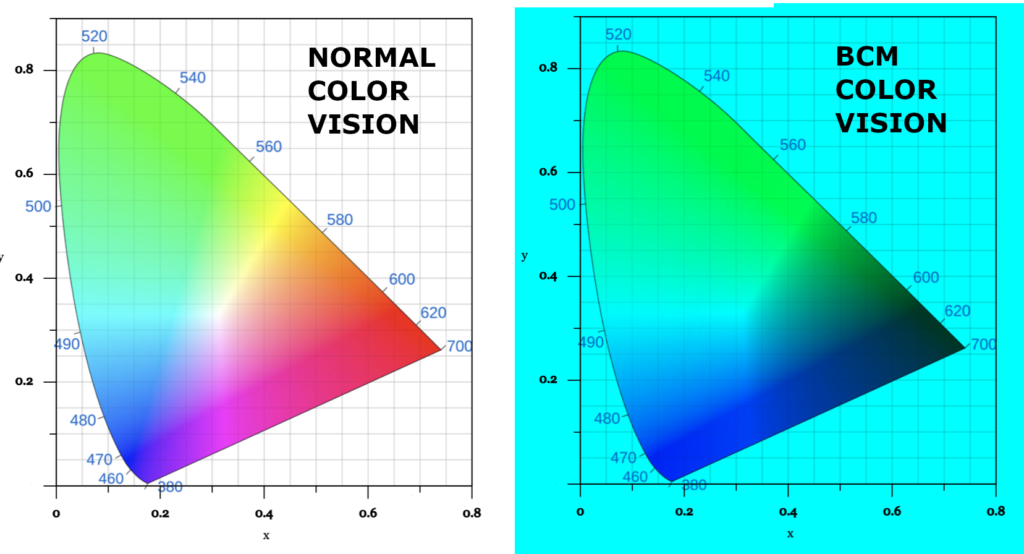
Figure 10 – Colors with Normal Vision vs. BCM Vision. With BCM vision or for normals wearing the simulation glasses the left and right will look nearly the same. This figure is most accurate when viewed on a monitor rather than printed. This is a CIE 1931 color standards organization chromaticity diagram.
SUMMARY
Based on Trichromacy Theory, we can now understand why the simulation glasses work. People with BCM use both S-cones for short wavelength light (blues) and rods for medium wavelength light (greenish wavelengths) in medium bright light. The simulation glasses work by filtering out red wavelengths leaving normals to see mainly with S-cones and M-cones. Normals then experience a 2-color dichromacy blue/green system approximating BCM color vision.
These BCM simulation glasses provide a “close enough” representation of BCM color vision to be very useful for family, teachers and doctors to better understand BCM vision.
References:
- Blackwell HR, Blackwell OM, (1961) Rod and cone receptor mechanisms in typical and atypical congenital achromatopsia. Vision Res 1: 62–107
- Luo X, Cideciyan AV, Iannaccone A, Roman AJ, Ditta LC, et al., (2015) Blue Cone Monochromacy: Visual Function and Efficacy Outcome Measures for Clinical Trials. PLOS ONE 10(4): e0125700. https://doi.org/10.1371/journal.pone.012570033
- Reitner, A., Sharpe, L. T., & Zrenner, E. (1991). Is colour vision possible with only rods and bluesensitive cones? Nature, 352(6338), 798–800. https://doi.org/10.1038/352798a0
- Alpern, M., Lee, G. B., Maaseidvaag, F., & Miller, S. S. (1971). Colour vision in blue-cone ‘monochromacy’. The Journal of physiology, 212(1), 211–233. https://doi.org/10.1113/jphysiol.1971.sp009318
- Cherry K, (2021) The Trichromatic Theory of Color Vision. https://www.verywellmind.com/what-is-the-trichromatic-theory-of-color-vision-2795831
- Rushton WAH, (1972). Review lecture. Pigments and signals in colour vision. The Journal of physiology, 220 (3): 1–31P. doi:10.1113/jphysiol. sp009719. PMC 1331666. PMID 4336741.
- Hunt RWG, Pointer MR, (2011) Measuring Color. John Wiley & Sons, Aug 2, 2011 – Technology & Engineering, p117-142
- Cao, D., Pokorny, J., Smith, V. C., & Zele, A. J. (2008). Rod contributions to color perception: linear with rod contrast. Vision research, 48(26), 2586–2592. https://doi.org/10.1016/j.visres.2008.05.001
- Blackwell HR, Blackwell OM, (1957) Blue mono-cone monochromacy: A new color vision defect. J Optical Soc Am 47: 338.
- Young, R. S., & Price, J. (1985). Wavelength discrimination deteriorates with illumination in blue cone monochromats. Investigative ophthalmology & visual science, 26(11), 1543–1549.


